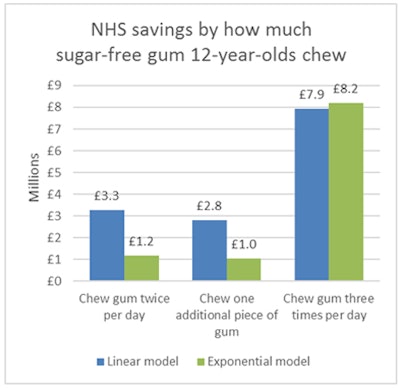
A recent economic analysis found chewing sugar-free gum may be able to save the U.K.'s National Health Service (NHS) millions. The analysis showed that if 12-year-olds in England chewed more gum, the NHS could save up to 8.2 million pounds ($11.6 million) per year.
Researchers from the York Health Economic Consortium and Plymouth University Peninsula School of Dentistry in the U.K. teamed up to study the economic benefits of adolescents chewing more gum. They hoped to find an easy yet effective way to help prevent costly procedures to treat dental disease (British Dental Journal, February 12, 2016, Vol. 220:3, pp. 121-127).
"The findings of this study are hugely exciting as they reveal a new and easy way of helping people improve their oral health," stated study author Elizabeth Kay, BDS, MPH, PhD, a professor at the Peninsula dental school, in a press release. "Clinical evidence has already proved that sugar-free gum can help prevent caries, and now we can also see a clear financial advantage."
Creating the model
While several scientific studies found chewing sugar-free gum, especially after consuming food, can help reduce the incidence and prevalence of caries, no other studies have been conducted that evaluate the financial benefits of the gum. The authors, therefore, set out to estimate how much money the NHS could save if more adolescents chewed gum after meals.
“Clinical evidence has already proved that sugar-free gum can help prevent caries, and now we can also see a clear financial advantage.”
The researchers assumed the cost of a restoration in a primary care setting was 75 pounds ($106), inpatient treatment for an extraction cost 1,165 pounds ($1,643), and 80% of extractions would take place with general anesthesia.
Their analysis included the population of 12-year-olds in the U.K., which is nearly 685,000 children. They decided to study this age group for the following reasons:
- The majority of tooth decay occurs before the age of 15.
- Teenagers are the most likely demographic to chew gum.
- Data about 12-year-olds' dental health were available.
Lindsay Claxton, the study's lead author and a research consultant at the York Health Economics Consortium, and colleagues created the model using current disease risk and chewing gum habits of 12-year-olds in England as well as results from a 2001 study by Lithuanian researchers published in Community Dentistry and Oral Epidemiology (August 2001, Vol. 29:4, 278-288).
The three-year Lithuanian study estimated the impact of chewing sugar-free gum on children ages 9 to 14. The U.K. researchers picked the Lithuanian study for their model because it was one of the more similar studies they could find to English children and because it had the most conservative results for baseline caries risk reduction.
Modeling cost savings
Claxton and colleagues created two different versions of the model, one with a linear frequency response and one with an exponential frequency response, to estimate potential cost savings. They used two different models because the benefits of chewing sugar-free gum less than three times per day were not available for the Lithuanian study. The authors noted that both versions are plausible; however, the linear model is more optimistic than the exponential.
The two versions of the model found that the NHS could save between 1 million pounds ($1.4 million) and 8.2 million pounds ($11.6 million) per year if 12-year-olds simply chewed more gum. If every 12-year-old in the U.K. chewed just one more piece of sugar-free gum per day than they already chew, the NHS could save 1 million pounds, and if every 12-year-old chewed sugar-free gum three times per day, the NHS could save 8.2 million pounds.
 Data courtesy of "Oral health promotion: the economic benefits to the NHS of increased use of sugar-free gum in the UK," British Dental Journal, February 12, 2016.
Data courtesy of "Oral health promotion: the economic benefits to the NHS of increased use of sugar-free gum in the UK," British Dental Journal, February 12, 2016.Improving future research
One of the biggest drawbacks to this study was lack of U.K.-based research on the effects of 12-year-olds chewing sugar-free gum, according to the study authors, and Claxton and colleagues hope future researchers study gum use within that specific population. The study also did not take into the account the cost of promoting chewing additional sugar-free gum or the cost the consumer would pay to purchase the gum.
However, the authors specifically picked data that would underestimate potential health savings and chose not to study the health benefits of preventing caries at such a young age. Therefore, the benefits of promoting more sugar-free gum could be much higher than the study estimates.
"Crucially, whilst these figures are significant, they refer only to the cost reductions for treating 12-year-olds in the U.K.," Dr. Kay stated. "If this model was to be applied to the whole population, then there is a real potential to create substantial NHS savings."



















